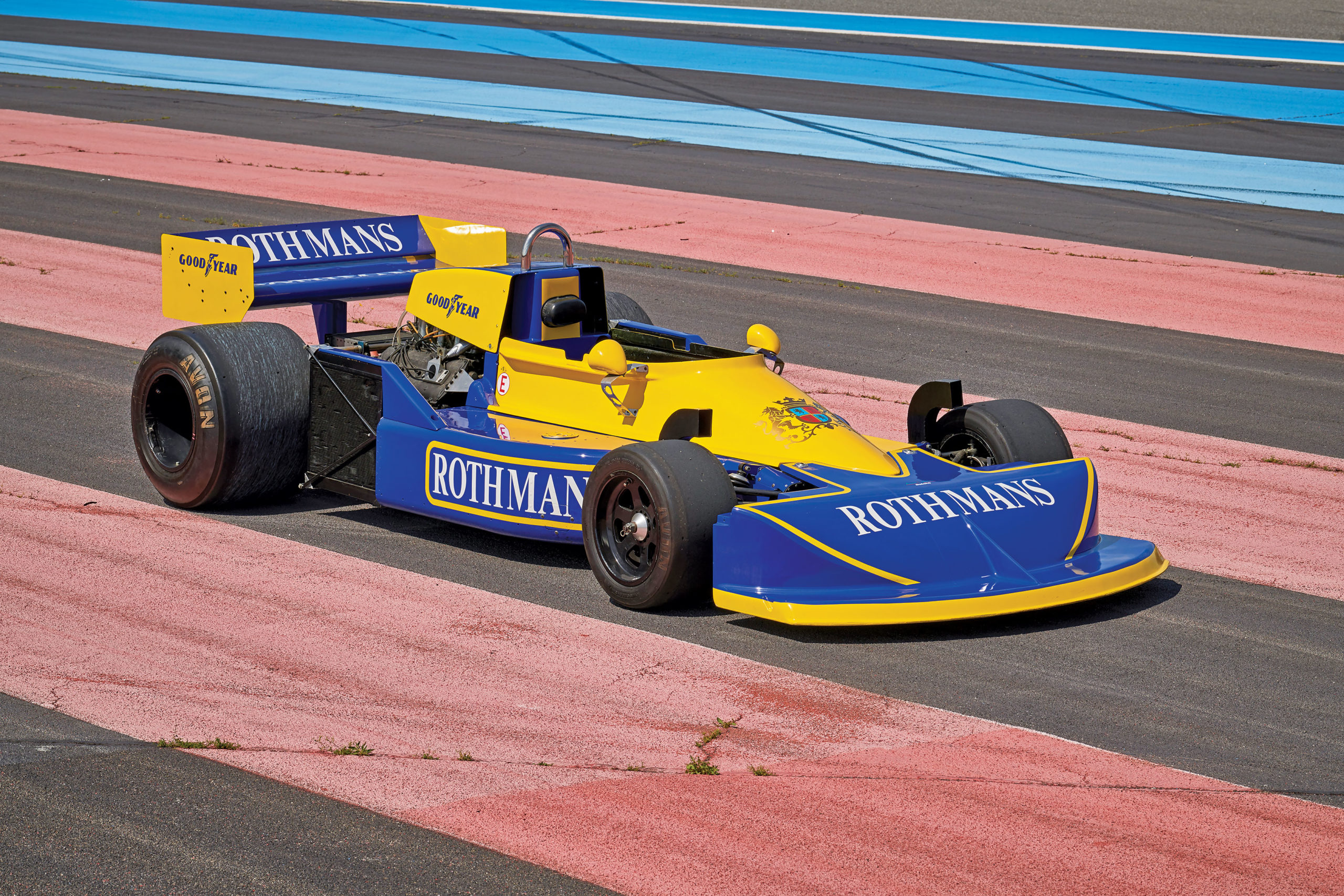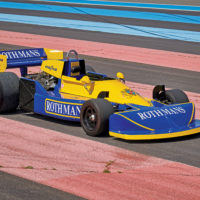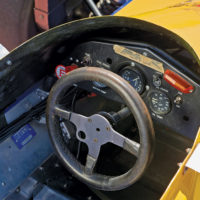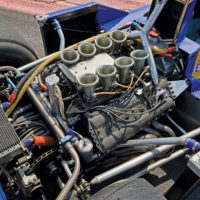SCM Analysis
Detailing
| Vehicle: | 1977 March 771 Formula One Racer |
| Years Produced: | 1977 |
| Number Produced: | 2 (1 remains) |
| Chassis Number Location: | Tag in cockpit |
| Engine Number Location: | Top rear of block above flywheel |
| Club Info: | Masters Historic Racing |
| Website: | http://www.mastershistoricracing.com |
| Alternatives: | 1976 Ferrari 312T2, 1976 BRM P-201, 1976 McLaren M23 |
This car, Lot 121, sold for $354,332 (€314,375), including buyer’s premium, at RM Sotheby’s Guikas Collection sale on November 19, 2021.
Those of us “of a certain age” who have been around the vintage- racing hobby for quite a while now, remember a time 15 or 20 years ago when all Formula One cars were mostly considered weapons to go play with. There was still a range of values, of course. In the early-2000s market for 3.0-liter “flat bottom” cars, marques like March were the base model, with a value in the $175k range. Ferraris were maybe four times that amount, but it mostly had to do with how much fun you could have. Collector values were only found in sports-racing and GT cars.
Times changed, and today a Ferrari 312T F1 will sell for 15 times what today’s subject March sold for, even though they shared starting grids back in 1976–77. Since I happen to have experience with both, this seems a good opportunity to discuss the differences and similarities that define “weapons” versus “collector” attributes in these Formula One bolides.
Forward March
Let’s start by talking about March Engineering. Formed in 1969 by four young English racers, primarily around the design talents of Robin Herd, the original intent was to design and build formula cars for commercial sale. At the time, the European market for Formula Three cars was buying between 80 and 100 cars per year, with the larger Formula Two cars close behind. Over the next 20 years, March became easily the most prolific builder of production racing cars in the world. It built its success on a simple concept: build uncomplicated, cost-effective (cheap) cars that were competitive and dependable, while being easy to set up, drive, and fix for the amateur and professional driver alike.
Those were the days when serious racing was still relatively affordable, so the racing-car market was growing quickly. An English team calculated that it ran a 15-race European Formula Three season in 1969 for £5,243 (roughly $12,000 at the time). Admittedly, this is close to $90,000 in today’s dollars, but you get the idea. Serious racing was something a committed driver could afford.
Business first, racing second
Formula One was different then as well, also much more accessible. Today a team must design and build its own car, build or arrange for an engine, field its own support structure, etc., all with huge budgets. Though there were teams that did that back then — Ferrari, BRM and Matra are examples — it was also perfectly acceptable to buy a chassis from one source, motors from another and transaxles from a third, then go racing.
This approach was made viable by the fact that Cosworth, which built the dominant 3.0-liter DFV engine, was willing to sell them to anyone. March was happy to participate. For 1970, its first year building Formula One chassis, it built 10 cars but only two for its own team.
I should mention terminology here. March named its cars by year and formula, so a 1970 Formula Two was a 702, while our subject 1977 Formula One was a 771. Over the next years, March kept to the pattern as a primarily commercial builder of Formula One, Two and Three cars. In Formula One, it would build a few cars for its own team and as many others as there were buyers. March did well enough as a company, but its factory race team was never well financed, making it notorious for changing liveries almost on a race-by-race basis as it found new sponsors. This, along with its cars running with other teams, meant March never developed the name recognition that Brabham, Tyrrell or Lotus did. It’s essentially the generic Formula One car of that era.
The 1976 season was the last big year for March in Formula One. Never inclined toward big risks or changes, March’s cars evolved slowly and remained solid mid-pack rides. Robin Herd and his compatriots were getting frustrated, and there was serious pressure from BMW to give up Formula One and concentrate on its successful BMW-powered Formula Two effort. March built six 761s, then for 1977 lengthened the tub a bit and moved the radiator to the front, only building two 771s (along with three 761Bs for customers). The 771 never really worked, one was destroyed, and our subject car has clearly been converted back to 761 layout (the radiators are in back on the sides). March then abandoned F1 until 1981.
Jewel vs. tool
Looking at the March beside a Ferrari 312T2 is almost a shock. They are both 1976 designs but are amazingly different. Where the Ferrari is a watch-like jewel, the 761 seems almost crude in its simplicity. The Ferrari is a symphony of tiny little machined pieces in precise harmony, while the March feels like a Formula Ford on steroids. It is uncomplicated, direct and purposeful. The most intriguing part is that they work equally well at getting around the track.
In its precision, the Ferrari becomes uncompromising. If you wear anything larger than 30×30 jeans, you will never be comfortable inside the cockpit. To get it to shift well, the levers, bellcranks and rods must be adjusted to within thousandths after the entire system is up to operating temperature (trust me on this). If you need to replace the flywheel/vibration dampener (they do go bad), Ferrari will have one built, but it will take six months. It’s a fabulous car, but don’t break it.
The March, on the other hand, is more easygoing. There is plenty of room in the cockpit, the engine is dependable, relatively cheap to run and fix, and your kid could rebuild the transaxle. Virtually all parts are a phone call away. The chassis is easy to set up and comfortable to drive. It really does feel like a very fast Formula Ford. Interestingly, if you expect a transformative experience in Formula One, the March can be a bit disappointing.
Again, for 80%–90% of drivers, the cars will turn the same lap times, but one is a jewel, the other a tool.
A racing weapon, fairly bought
So what do we make of the world’s only surviving March 771? To start with, it is purely a weapons-grade toy, essentially just a 761, so nothing rare. There is really nothing collectible about it, and it carries appropriate paddock status (you will never be accepted at Monaco). This car has clearly been sitting for a while, so it will require probably another $30,000 before you put it on the track, which needs to be factored in. All in, it is a reasonable chunk of money to commit.
On the other hand, if you want to go and play in vintage Formula One racing, there are few (if any) more cost-efficient ways of doing so. Except for Monaco, it will always get a welcome entry, and it is commodious and competitive, if not exotic. Nothing like this is cheap, but this one was fairly bought. ♦




